The universe has been an appealing subject in the scientific world as well as in sci-fi literature and movies. Scientists have already landed humans on the moon successfully. However, even though Rovers and other spacecrafts have landed on Mars, we still haven’t sent humans on such a journey.
I believe that seeking life on a new planet is a crucial mission for the further development of science, as well as for the sake of future generations when Earth becomes uninhabitable.
Since 2017, TAMK has been a partner in the NASA Epic Challenge project, created by NASA’s astronaut Dr. Charles Camarda. Various stakeholders are involved in this project, including universities from around the world. Each year, students are asked to create solutions for Mars exploration and colonization.
By design, the Epic Challenges are a combination of complex problems with many interacting elements within. Therefore, they require expertise from various fields of study. The Epic Challenges are momentous and become a motivating force for a large audience, including students, who can explore out-of-the-box ideas for the future of Mars colonization.
Why Mars?
The fourth planet of our solar system is only 1/6 of the Earth’s size and more than 142 million miles away from the sun.
Currently, there is evidence that water once flowed on Mars, and there are polar ice caps, volcanoes, and canyons. Furthermore, the surface of Mars is rich in iron which, for example, could be valuable for steel manufacturing in civil and material engineering.
Most importantly, Mars is considered the most similar planet to Earth in our solar system, because of its day/night rhythm (24 hours, 39 minutes and 35 seconds). Moreover, the planet’s thin atmosphere, weather, seasons, and sufficient gravity (37% of Earth’s gravity) can play a vital role in human adaptation.
With all this interesting information, many believe that Mars is the ideal planet for the next human landing.
TAMK’s Epic Challenge
This two-semester intensive training program is worth of 15 study credits. During the autumn semester, the students can choose to only take an introduction course (1 credit) or take the whole course (5 credits). Then, the students can commit to completing the course during the spring semester and get a maximum of 10 credits.
During the autumn semester, we were split into groups of 5-6 students. We were introduced to valuable information and data about Mars by many experts, including astronaut Dr. Charles Camarda. While working as a team, we were encouraged to explore ideas and solutions which we prototyped in Spring 2021. There were no strict guidelines or restrictions on topics. On the contrary, we were free to survey any ideas we liked, even the ones that seemed impossible! 😀
TAMK Principal Lecturer in Mechanical Engineering, Antti Perttula held weekly workshops together with experts. In these workshops, they presented various topics relevant to Mars exploration and organized exercises to strengthen our skills-sets.
Introducing team Marsfellows
Our team was called Marsfellows and our mission was to help scientists explore the shelter options for humans on Mars. We designed an autonomous rover system that supports the exploration and mapping of Mars’ caves or lava tubes.
We focused on 2D mapping with Hector Slam and 3D scanning with Matlab. We were able to create a real-time 2D map that can help explore unknown environments. In our prototype, we have implemented 3D printing techniques to design bases for devices and we have utilized Raspberry Pi to control the systems with Rplidar A1 and Lidar lite v3.

Working as a team, we overcame any obstacles and delivered our ideas and prototype product. Our team has had a fluctuation in team members but with a great diversity of fields such as mechanics, aerospace, automation, wireless and environmental engineering. We took these opportunities to solve the various aspects of our Epic Challenge. Since the problem was huge and complex, we did not complete 100% of the goals we set, but our main goal of mapping has been fulfilled.

Overall, I am delighted with my contribution to the team and project. I have learned quite a lot in self-studying skills and team collaboration. I also had a chance to know about ROS (Robot Operating System) which has widened my horizon in robotics technologies.
If you want to read more about our work, please visit: http://marsfellow.project.tamk.cloud/ to get more information 😀
Join NASA Epic Challenge
TAMK Epic Challenges is a great opportunity for study credits and a cool project in your CV.
All fields of study are welcome. Each one’s expertise and specialization can be useful in the NASA Epic Challenge project.
This special course can be perfect for you if you are:
- A quick learner and self-motivated student
- Motivated with sufficient skills in your field of study
- Work well in multidisciplinary and multicultural teams
- Passionate about Mars and consider Mars sustainability important
You will be able to apply for next academic year’s TAMK Epic Challenge course in August 2021. There should be an announcement on intranet. Do not miss the chance to become TAMK’s Epic Challenger! 😀

Images:
Main image by NASA’s archives
Figures by Yen Tran and Marsfellows team of TAMK’s Epic Challenge





